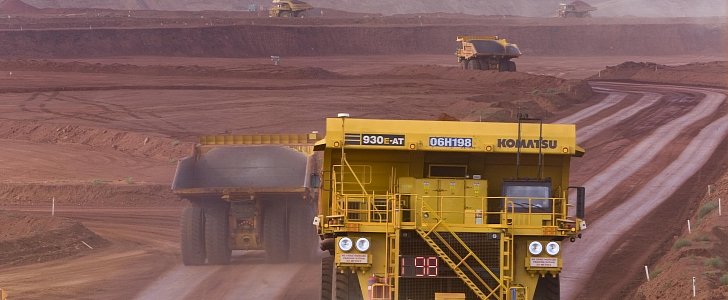Here you were thinking Google was the only big player on the market investing money to create a road-legal fleet of self-driving vehicles, when, in fact, on the other side of the world, the real big boys are hitting the road. And when we say big, we mean ultra class, rigid frame trucks with a payload capacity of up to 320 short tons (290 t).
When you look at a regular person sitting next to one of these trucks, you feel like watching a science fiction movie where the heavy load machines later turn into alien robots. These monsters are that big; you can’t even drive them on the highway. Yet, believe it or not, the two-axle, rigid frame monsters run with e-juice.
The premiere is huge and reminds us of the future that directors in Hollywood envisioned decades ago. The difference is that we’re not harvesting resources on an another planet, but here, at home. Still, this is a hell of a step forward that represents the beginning of a new era in the heavy-load automotive world.
According to ABC News Australia, the first two mines in the world to start moving all of their iron ore using fully remote-controlled trucks have just gone online in Western Australia’s Pilbara. Rio Tinto is the mining giant running the project, although its direct competitors are on their way towards launching their fleet of big boys soon.
Therefore, people in the industry believe each truck can save around 500 work hours per year. With the change, work conditions improve, efficiency becomes a rule, and the probability of accidents on sights should be a lot smaller if not even zero.
Josh Bennett, the person managing operations at the Yandicoogina mine and running 22 driverless trucks on the site, told the source, “What we have done is map out our entire mine and put that into a system, and the system then works out how to maneuver the trucks through the mine.”
As far as we can tell, the company is using Komatsu’s Frontrunner Autonomous Haulage System, that utilizes GPS navigation to allow large electric mining trucks to operate to an elaborate plan rather than an operator.
“AutoHaul is the world’s first fully autonomous heavy haul, long distance railway system, a key part of our Mine of the Future program. We have invested US$518 million in autonomous trains for our Pilbara rail network. AutoHaul will facilitate the additional capacity required during rapid expansions, without needing to make a substantial investment in additional trains, as we grow our iron ore business to produce 360 million tonnes a year.”
The premiere is huge and reminds us of the future that directors in Hollywood envisioned decades ago. The difference is that we’re not harvesting resources on an another planet, but here, at home. Still, this is a hell of a step forward that represents the beginning of a new era in the heavy-load automotive world.
According to ABC News Australia, the first two mines in the world to start moving all of their iron ore using fully remote-controlled trucks have just gone online in Western Australia’s Pilbara. Rio Tinto is the mining giant running the project, although its direct competitors are on their way towards launching their fleet of big boys soon.
Controlled by people sitting 1,200 km away
They use the new toys to run pits at the company’s Yandicoogina and Nammuldi mine sites, with workers controlling the driverless trucks largely from an operations center in Perth, 1.200 kilometers (745 miles) away. The company is now operating 69 driverless vehicles across its mines. According to the source, the vehicles can run 24 hours a day, 365 days a year, without a driver who needs bathroom or lunch breaks.Therefore, people in the industry believe each truck can save around 500 work hours per year. With the change, work conditions improve, efficiency becomes a rule, and the probability of accidents on sights should be a lot smaller if not even zero.
Josh Bennett, the person managing operations at the Yandicoogina mine and running 22 driverless trucks on the site, told the source, “What we have done is map out our entire mine and put that into a system, and the system then works out how to maneuver the trucks through the mine.”
As far as we can tell, the company is using Komatsu’s Frontrunner Autonomous Haulage System, that utilizes GPS navigation to allow large electric mining trucks to operate to an elaborate plan rather than an operator.
Autonomous Railway next
And if these self-driving huge beasts have not impressed you, the next thing the company is investing loads of money in sure will. Here's a little about it:“AutoHaul is the world’s first fully autonomous heavy haul, long distance railway system, a key part of our Mine of the Future program. We have invested US$518 million in autonomous trains for our Pilbara rail network. AutoHaul will facilitate the additional capacity required during rapid expansions, without needing to make a substantial investment in additional trains, as we grow our iron ore business to produce 360 million tonnes a year.”

